José Manuel Boronda
José Manuel Boronda (September 5, 1803 – July 24, 1878), was the first ranchero settler in Carmel Valley, California. He and Vicente Blas Martínez were given the 6,625-acre (26.81 km2) Rancho Los Laureles Mexican land grant in present-day Monterey County, California on September 20, 1839, by Governor Juan Alvarado.[1][2][3] Many of the Boronda historic sites still exist, including the Los Laureles Lodge, Carmel Valley Village, Road-Boronda Road Eucalyptus Tree Row, Manuel Boronda Adobe (1817), José Manuel Boronda Adobe, and the Jose Eusebio Boronda Adobe.[4]
José Boronda | |
|---|---|
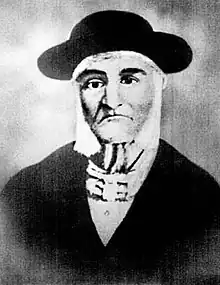 José Manuel Boronda (1803–1878) | |
| Born | José Manuel Boronda September 5, 1803 |
| Died | July 24, 1878 (aged 74) |
| Occupation(s) | Farmer, dairyman |
| Spouse | Juana Maria Inocencia Cota |
| Children | 15 |
Early life
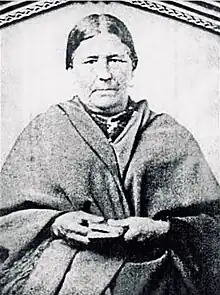
José Manuel Boronda Jr. was born on September 5, 1803, in San Jose, California. His father was Captain José Manuel Borunda Sr. (1750-1826) and his mother was Maria Gertrudis Higuera (1776-1851). Her parents from Sinaloa, Mexico, had settled in Monterey, California. The senior Boronda was born in Zacatecas, Mexico in 1750. He was a corporal in the Spanish Army and went with Junípero Serra on his second expedition to Alta California. By 1790, he was put on duty at the Presidio of San Francisco. When he retired he and his family moved to Monterey, where he built the three-room Boronda Adobe in 1817, which is the oldest remaining adobe residence in Monterey.[5] He conducted Monterey's first school for boys at this adobe.[6][7][8]
The three sons of Manuel and Gertrudis Boronda were: José Canuto Boronda (1792-1882), grantee of Rancho Potrero de San Luis Obispo; José Manuel Boronda Jr. (1803-1878), grantee of Rancho Los Laureles; José Eusebio Boronda (1808-1880) grantee of Rancho Rincon de Sanjon..[9]
José Manuel Boronda Jr., married Maria Inocencia Lidia Cota (1805–1894) on May 2, 1821, at San Carlos Cathedral in Monterey. Juana was born on December 28, 1805, in Santa Barbara, California. She was the daughter of Manuel Antonio Cota (1779-1826) and Maria Gertrudis Romero (1781–1817). The Boronda's had 15 children in 25 years.[9][8]
Rancho Rincón de Sanjón
José Eusebio Boronda was the second son of José Manuel Sr. and Maria Boronda. He married Maria Josefa Buelna (1817-1864) on September 5, 1831. Maria Buelna was the daughter of Antonio Buelna, grantee of Rancho San Francisquito and Rancho San Gregorio. Boronda served as Mayordomo (Butler) of Rancho Los Vergeles. In 1839, Boronda and his family settled on a one and one half square league, Rancho Rincón del Sanjón which he called San José, and which he was granted in 1840.[10][6] He built the Jose Eusebio Boronda Adobe in Salinas in 1846.[11] The adobe was listed on the National Register of Historic Places in 1973,[12] and is a California Historical Landmark.[13]
Rancho Potrero de San Luis Obispo
José Canuto Boronda was a soldier at Monterey and Mission San Antonio, San Miguel and San Juan Bautista. He married Maria Francisca Castro (1799-1830) and they had nine children. He received the Rancho Potrero de San Luis Obispo land grant in about 1842. His daughter Maria Concepcion Boronda (1820-1906) received the patent in 1870.[14][15]
Professional life
Rancho Los Laureles
Governor Juan Alvarado was generous to the Borondas. On September 20, 1839, he granted Rancho Los Laureles to José Manuel Boronda, which was 6,625-acre (26.81 km2) in upper Carmel Valley, California. The name Los Laureles comes from the California Bay Laurel tree. It was bordered to the east by the Rancho Tularcitos, near today's Carmel Valley Village, and on the west by the James Meadows Tract, near Garland Ranch Regional Park.[16][5]
It was the year 1840. Don José Manuel Boronda rode at the head of the pack train that carried the family's possessions. Beside him was his eldest son, the eighteen-year-old Juan de Mata, and at the rear, in the bulging carretas hat lumbered up the steep trail out of Monterey, were Doña Juana and the younger children. Emerging from the deep shade, they saw the Carmel River, glistening between willow-bordered banks below them. Beyond were the tawny flanks of the towering Santa Lucias, tapering to a dark green sea-girt point.
— Cahpter 14: The Carmel Valley[16]
In 1840, José and Maria settled at Rancho Los Laureles, the first ranchero to setup a permanent residence in Carmel Valley. The family farmed and raised cattle, horses, chickens, and ran a dairy. They grew tomatoes, chilies, and squash. The only neighbors were Domingo Peralta and his wife Maria Loreta Onésimo (1819–1892), who were Rumsen-Esselen Native Americans. After Loretta's husband died, she married James Meadows, who had the adjacent Meadows Tract.[17][16][8]
Juana was the first to bring Spanish cheese to Carmel Valley, called Queso del País, which in Spanish means "cheese of the county." She used a Spanish original recipe to make her white-yellow cheese.[17][8][5] David Jacks is credited as being the first to market and popularize what was named Monterey Jack cheese.[18]
With the cession of California to the United States following the Mexican-American War, the 1848 Treaty of Guadalupe Hidalgo provided that the land grants would be honored. As required by the California Land Act of 1851, a claim for Rancho Los Laureles was filed with the Public Land Commission in 1853,[2] and the grant was patented to José M. Boronda and his son, Juan de Mata Boronda (1822-1901) in 1866. In 1851, the Borondas purchased Vicente Blas Martinez and his wife's half-interest in Rancho Los Laureles.[14]

In 1868, the Borondas sold Rancho los Laureles for $12,000 (equivalent to $263,820 in 2022),[8] to Elihu Avery, who sold it to Ezekiel Tripp in 1874. Nathan W. Spaulding, later Oakland 's fifteenth Mayor, purchased a half interest on April 27, 1874.[5]: p111 [19][16]
Spaulding operated the property from 1874-1881. His brother-in-law, Kinzea Klinkenbeard, was appointed as manager and built what became the Los Laureles Lodge. In 1882, the Pacific Improvement Company (PIC) purchased Rancho Los Laureles and hired William Hatton as manager. In 1919, PIC sold their holdings, including Los Laureles, to Samuel FB Morse, and his Del Monte Properties, who offered the land to wealthy developers.[8][20][5]: p111
Boronda Adobe
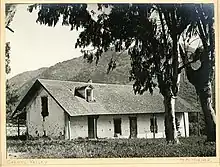
José and Maria Boronda lived in a three-room adobe house, built by the mission Indians, near the Carmel River, from 1840 to 1868. The Boronda Adobe is the oldest building in Carmel Valley having been built ca. 1833.[4][5] It had three rooms, dirt floors, and a thatched roof (unlike the Boronda adobe in Salinas). A second story was added by the Borondas.[17][21][20]
In 1890, William Hatton managed the Hatton Upper Dairy on the old Rancho Los Laureles. Guests from the Hotel Del Monte would visit the Los Laureles lodge on the property to ride, hunt, and explore the trails. Hatton modernized the diary operations at the old Boronda adobe, adding Durham cattle to the Holsteins that increased the milk butterfat content. Large vats and presses were installed to manufacture Monterey Jack cheese.[17]: p44
By the 1930s the Boronda adobe had fallen into disrepair and was used to house cattle. In 1947, George Sims purchased the adobe and restored the home and grounds and lived on the property until 1960. It can be seen today on Boronda Road in Carmel Valley. Today, the adobe is a private home and is not open to the public.[17][4][21]
Rancho Ex-Mission Soledad
Rancho Ex-Mission Soledad was a 8,900-acre (36 km2) land grant in the Salinas Valley, in present-day Monterey County, California. It was given in 1845 by Governor Pío Pico to Feliciano Soberañes (1788-1868).[3] Francisco Soberañes married Ysabel Boronda (1827-1887), daughter of José Manuel Boronda. Soberanes's daughter, Maria Josefa Soberanes, was granted Rancho Los Coches in 1841.[22] Feliciano's son, Francisco Maria Soberañes (1818-1887), was granted the eleven square league Rancho Sanjon de Santa Rita in 1841.[23]
Death
José Boronda died of a heart attack on July 24, 1878, in Castroville, California, at the age of 74. His funeral was attended by large number of people. He was buried at the Castroville Public Cemetery in Moss Landing, California.[24]
Legacy
The Boronda legacy remains strong today in the Boronda historic sites, including:
- Los Laureles Lodge, 313 West Carmel Valley Road, Carmel Valley
- Road-Boronda Road Eucalyptus Tree Row, Boronda Road, Carmel Valley[25]
- Manuel Boronda Adobe (1817), 100 Boronda Road, Monterey
- José Manuel Boronda Adobe, Boronda Road, Carmel Valley
- Jose Eusebio Boronda Adobe (1844), 333 Boronda Road, Salinas[12][11]
Gallery
 Jose Eusebio Boronda Adobe, Salinas
Jose Eusebio Boronda Adobe, Salinas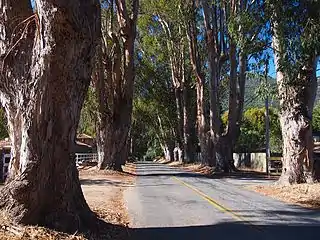 Road-Boronda Road Eucalyptus Tree Row, Carmel Valley
Road-Boronda Road Eucalyptus Tree Row, Carmel Valley
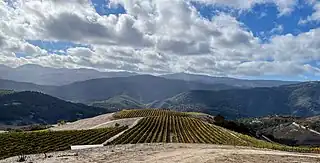 Holman Ranch Vineyard, Carmel Valley
Holman Ranch Vineyard, Carmel Valley
See also
References
- "California, U.S., Spanish Land Records, 1784-1868 for Jose M. Boronda". California, U.S., Spanish Land Records, 1784-1868. p. 17. Retrieved January 18, 2023.
- "Finding Aid to the Documents Pertaining to the Adjudication of Private Land Claims in California, circa 1852–1892". Online Archive of California. Retrieved January 12, 2023.
- Hoffman, Ogden (1862). Reports of Land Cases Determined in the United States District Court for the Northern District of California. p. 73. Retrieved January 18, 2023.
{{cite book}}:|work=ignored (help)CS1 maint: location missing publisher (link) - Marion Crush (August 1, 1963). "Carmel Valley Memories Of Joe Hitchcock". Carmel Pine Cone. Carmel Valley, California. Retrieved January 19, 2023.
- Hale, Sharron Lee (1980). A Tribute to Yesterday: The History of Carmel, Carmel Valley, Big Sur, Point Lobos, Carmelite Monastery, and Los Burros. Santa Cruz, California: Valley Publishers. pp. 110–111. ISBN 9780913548738. Retrieved March 18, 2022.
- Robert B. Johnston. "José Eusebio Boronda". Monterey county Historical Society. Retrieved January 19, 2023.
- http://borondaadobe.com/ Boronda Adobe of Monterey Archived 2010-02-14 at the Wayback Machine
- Elizabeth Barratt (September 14, 2008), The Boronda Family and Rancho Los Laureles
- "Historical Information for José Manuel Boronda". FamilySearch. Retrieved January 18, 2023.
- "California, U.S., Spanish Land Records, 1784-1868 for Jose Ensebio Boronda". California, U.S., Spanish Land Records, 1784-1868. p. 233. Retrieved January 19, 2023.
- "History of the Boronda Adobe". Monterey County Historical Society. Salinas, California. Retrieved January 19, 2023.
- "National Register Information System". National Register of Historic Places. National Park Service. March 13, 2009.
- "Jose Eusebio Boronda Adobe". Office of Historic Preservation, California State Parks. Retrieved October 10, 2012.
- "Report of the Surveyor General 1844 - 1886" (PDF). Sacramento State Office. Sacramento, California. 1886. Retrieved January 18, 2023.
- "California, U.S., Spanish Land Records, 1784-1868 for Maria Concepcion Boronda". California, U.S., Spanish Land Records, 1784-1868. p. 17. Retrieved January 18, 2023.
- Fink, Augusta (2000). Monterey County: The Dramatic Story of Its Past. San Francisco: Western Tanager Press/Valley Publishers. pp. 194–196. ISBN 9780913548622. Retrieved January 6, 2023.
- Barratt, Elizabeth (2009). Carmel Valley. pp. 36–38. ISBN 9780738571621. Retrieved January 6, 2023.
{{cite book}}:|work=ignored (help) - "David Jacks, Well Known Californian, Dies in North". Los Angeles Herald. January 12, 1909. Retrieved January 18, 2023.
- "This is Carmel Valley". The San Francisco Examiner. San Francisco, California. October 12, 1958. p. 190. Retrieved October 11, 2021.
- John Jernegan (August 14, 1975). "Bend in the river". Carmel Valley Outlook. Carmel Valley, California. Retrieved January 19, 2023.
- "Historic Valley Adobe". Carmel Valley Outlook. Carmel Valley, California. April 20, 1966. Retrieved January 19, 2023.
- "California, U.S., Spanish Land Records, 1784-1868 for Maria Josefa Soberañes". California, U.S., Spanish Land Records, 1784-1868. p. 478. Retrieved January 18, 2023.
- "California, U.S., Spanish Land Records, 1784-1868 for Francisco Soberañes". California, U.S., Spanish Land Records, 1784-1868. p. 63. Retrieved January 18, 2023.
- "Over Forty Years Ago (Reprinted From Salinas Index of August 1, 1878)". Salinas Daily Index. Salinas, California. November 17, 1920. Retrieved January 19, 2023.
- Barratt, Richard H.; Elizabeth R. Barratt (July 16, 2007). "National Register of Historic Places Registration Form: Carmel Valley Road-Boronda Road Eucalyptus Tree Row". National Park Service. Retrieved November 5, 2013.
{{cite journal}}: Cite journal requires|journal=(help)